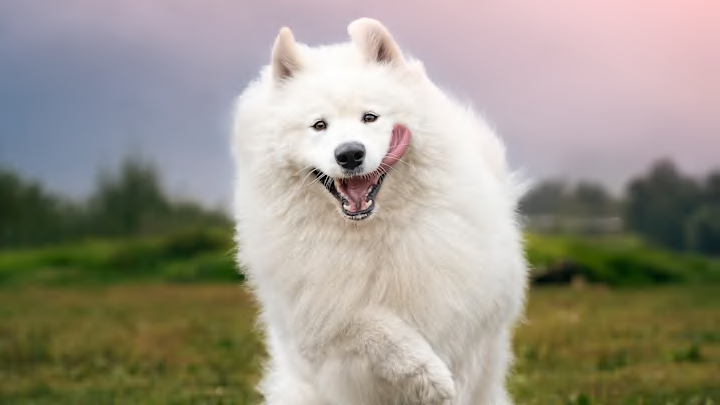It’s impossible to resist the fox-like charm of the Samoyed. Learn more about these fluffy dogs and their history in the tundra.
1. Samoyeds come from Siberia.
These dogs originated as companions to the Nenets people, an Indigenous group that lives in Siberia. (Samoyed is an outdated term for the Nenets.) The working canines pull sleds, hunt game, and herd reindeer. But they are just as useful inside the home: The friendly dogs play with children and keep their owners warm with their fluffy coats.
2. Explorers used Samoyeds on their trips to the Poles.
In the 19th century, adventurers acquired some of these dogs to help them on expeditions to the North and South Poles. Norwegian explorer Fridtjof Nansen chose Sammies for his trip to the North Pole in 1893 because of their endurance and trainability. Although his trip was not successful for a number of reasons, the dogs proved to be excellent sled dogs.
English explorer Robert Falcon Scott and Norwegian explorer Roald Amundsen also used the dogs on their expeditions to the South Pole. Scott had a team of 33 dogs; Amundsen had 52. Amundsen beat Scott to the Pole with his team, led by a Samoyed named Etah.
3. Samoyeds are closely related to wolves.
The Samoyed is a spitz breed, meaning they’re part of group of dogs closely related to wolves. You can always spot one by their fox-like faces and curly tails (other examples include shiba inus, American Akitas, and chow chows). In 2011 scientists discovered a 33,000-year-old fossil of a dog. The fossil—named the ‘Altai dog’ after the mountain range it was discovered on—is from a dog/wolf hybrid that seems to have been more dog than wolf. After conducting DNA testing, researchers found that the modern breed most closely related to this ancient hybrid is the Samoyed.
4. Samoyeds sing ...
Possibly due to the Samoyed’s genetic closeness to wolves, the breed is known to howl. Their melodious yodels sound a lot like singing. You can get most Sammies to sing just by playing them some music or starting to howl yourself—the dogs love to harmonize.
5. ... and smile.
As if the singing wasn’t cute enough, the dogs also smile. Dubbed the “Sammy smile,” the happy dogs have lips that naturally curve upwards. People love the Sammy smile so much, you’re just a quick web search away from a number of photo roundups dedicated to their gleeful mugs.
6. Samoyeds are (relatively) odorless.
Unlike certain breeds (we’re looking at you, basset hounds), the Samoyed is a stink-free pooch. You don’t need to bathe Sammies as much as you would other dogs, but frequent brushings are a must to keep their fur from matting.
7. You can make clothes from their extra fur.
Samoyeds have a thick double coat. The bottom is soft and wool-like while the top is coarse and straight. The dogs shed so much that many owners have gotten in the habit of collecting all the excess fur. This surplus can be spun into a yarn that can be used to make clothing. The material is warm and strong (and not to mention odorless), making it a great alternative to sheep’s wool.
8. There are two ways to pronounce their name.

You can say Sammy-ed or Sah-moy-ed; either is correct.
9. Samoyeds are pack animals.
Samoyeds are pack animals by nature, so they don’t do well by themselves. Sammies left alone are known to wreak havoc on their homes out of boredom and aggravation.
10. Queen Alexandra was a fan of Samoyeds.
Alexandra of Denmark was an avid supporter of the breed, and kept a collection of them in the royal kennel. “The queen is distinctly a judicious fancier of dogs, who provides for them well in kennel without coddling, and, pays to them a sufficient amount of personal attention,” a 1903 issue of Country Life reported. “Moreover the pictures show that the Samoyed is alike fascinating in puppyhood and a noble dog when adult.”
A version of this story originally ran in 2016; it has been updated for 2022.
